-
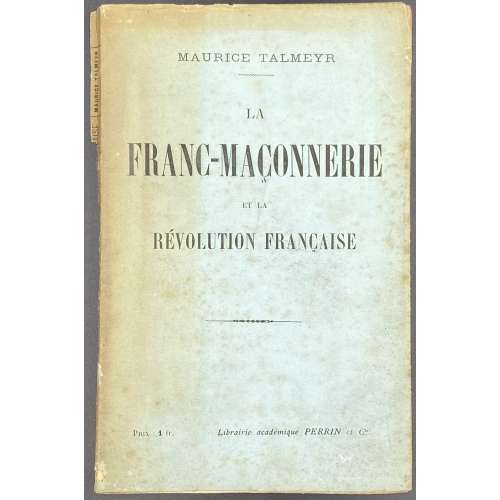 Cover: MAURICE TALMEYR | LA | FRANC-MAÇONNERIE | ET LA | RÉVOLUTION FRANÇAISE | — | Prix : 1 fr. […] Librairie académique PERRIN et Cie. Title page: MAURICE TALMEYR | LA | FRANC-MAÇONNERIE | ET LA | RÉVOLUTION FRANÇAISE | — | PARIS | LIBRAIRIE ACADÉMIQUE DIDIER | PERRIN ET Cie, LIBRAIRES–ÉDITEURS | 35, QUAI DES GRANDS-AUGUSTINS, 35 | 1904 | Tous droits réservés || Autograph: Inscription to h.t. to Charles Foley from the author. Bibiographical description: Blue lettered publisher’s wrappers, 19 x 12 cm, pagination: [8] [1] 2-94 [2], collation: 8vo, π4 1-68. The Russian translation Н. Л. Фран-масонство и государственная измена. — СПб.: Издание В. П., 1906 is here: LIB-0940.2016. Contributors: Maurice Talmeyr [Marie-Justin-Maurice Coste] (French, 1850 – 1931) Pierre-Paul Didier (French, 1800 – 1865) Émile Perrin (French, 1828 – 1884)
Cover: MAURICE TALMEYR | LA | FRANC-MAÇONNERIE | ET LA | RÉVOLUTION FRANÇAISE | — | Prix : 1 fr. […] Librairie académique PERRIN et Cie. Title page: MAURICE TALMEYR | LA | FRANC-MAÇONNERIE | ET LA | RÉVOLUTION FRANÇAISE | — | PARIS | LIBRAIRIE ACADÉMIQUE DIDIER | PERRIN ET Cie, LIBRAIRES–ÉDITEURS | 35, QUAI DES GRANDS-AUGUSTINS, 35 | 1904 | Tous droits réservés || Autograph: Inscription to h.t. to Charles Foley from the author. Bibiographical description: Blue lettered publisher’s wrappers, 19 x 12 cm, pagination: [8] [1] 2-94 [2], collation: 8vo, π4 1-68. The Russian translation Н. Л. Фран-масонство и государственная измена. — СПб.: Издание В. П., 1906 is here: LIB-0940.2016. Contributors: Maurice Talmeyr [Marie-Justin-Maurice Coste] (French, 1850 – 1931) Pierre-Paul Didier (French, 1800 – 1865) Émile Perrin (French, 1828 – 1884) -
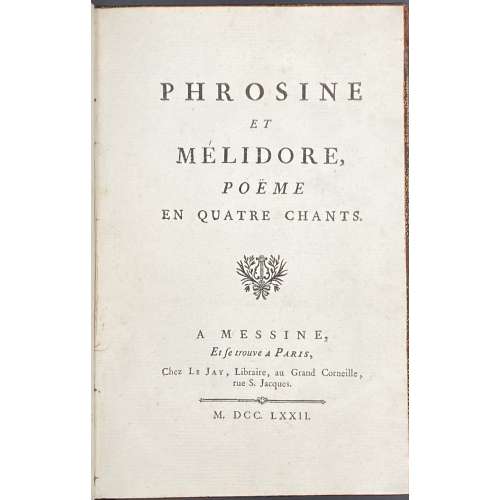 Title page: PHROSINE | ET | MELIDORE, | POËME | EN QUATRE CHANTS. | A MESSINE, | Et se trouve A Paris, | Chez Le Jay, Libraire, au Grand Corneille, | rue S. Jacques. | M. DCC. LXXII. || Pagination : ffl, [2] – h.t. / blank, [2] t.p. / blank, [1] 2-55 [56 blank], bfl ; 4 copperplate engravings by Nicolas Ponce (French, 1746 – 1831) after Charles Eisen (French, 1720 – 1778), one before each chant. Collation: 8vo; π2 (h.t., t.p. ) A-C8 D4. Binding: 20.5 x 14 cm, full mottled calf, gilt-ruled with triple fillet, flat spine, gilt in compartments, black label with gilt lettering, printed on laid paper, all edges red. Catalogue raisonné: Cohen de Ricci p. 132; J. Lewine: p. 53. Contributors: Nicolas Ponce (French, 1746 – 1831) Jean Charles Baquoy (French, 1721–1777) Charles-Dominique-Joseph Eisen (French, 1720 – 1778) Pierre-Joseph Bernard [Gentil-Bernard] (French, 1708 – 1775).
Title page: PHROSINE | ET | MELIDORE, | POËME | EN QUATRE CHANTS. | A MESSINE, | Et se trouve A Paris, | Chez Le Jay, Libraire, au Grand Corneille, | rue S. Jacques. | M. DCC. LXXII. || Pagination : ffl, [2] – h.t. / blank, [2] t.p. / blank, [1] 2-55 [56 blank], bfl ; 4 copperplate engravings by Nicolas Ponce (French, 1746 – 1831) after Charles Eisen (French, 1720 – 1778), one before each chant. Collation: 8vo; π2 (h.t., t.p. ) A-C8 D4. Binding: 20.5 x 14 cm, full mottled calf, gilt-ruled with triple fillet, flat spine, gilt in compartments, black label with gilt lettering, printed on laid paper, all edges red. Catalogue raisonné: Cohen de Ricci p. 132; J. Lewine: p. 53. Contributors: Nicolas Ponce (French, 1746 – 1831) Jean Charles Baquoy (French, 1721–1777) Charles-Dominique-Joseph Eisen (French, 1720 – 1778) Pierre-Joseph Bernard [Gentil-Bernard] (French, 1708 – 1775). -
![Auguste Vitu. Les réunions publiques à Paris 1868-1869. — Paris: E. Dentu, 1869. — pp.: [1-5] 6-151 [1].](https://varshavskycollection.com/wp-content/uploads/2021/02/LIB-2432.2020-a-500x500.jpeg) Cover: LES | RÉUNIONS PUBLIQUES | A PARIS | 1868 — 1869 | PAR | AUGUSTE VITU | TROISIÈME ÉDITION | Augmentée d’un Appendice contenant les Jugements et Arrêts | rendus à Paris en matière de réunions publiques | PARIS | E. DENTU, LIBRAIRE-ÉDITEUR | PALAIS-ROYAL, 17-19, GALERIE D’ORLÉANS | MAI 1869 || ; t.p. similar with no dash between 17 and 19 in the bottom. Pagination: [1-5] 6-151 [1]; collation: 8vo, [1]8 2-98 103; 23 x 14 cm, publisher’s lettered blue paper wrappers. Printer: Dubuisson et Cie (Paris). Vitu, Auguste-Charles-Joseph (French, 1823 – 1891)
Cover: LES | RÉUNIONS PUBLIQUES | A PARIS | 1868 — 1869 | PAR | AUGUSTE VITU | TROISIÈME ÉDITION | Augmentée d’un Appendice contenant les Jugements et Arrêts | rendus à Paris en matière de réunions publiques | PARIS | E. DENTU, LIBRAIRE-ÉDITEUR | PALAIS-ROYAL, 17-19, GALERIE D’ORLÉANS | MAI 1869 || ; t.p. similar with no dash between 17 and 19 in the bottom. Pagination: [1-5] 6-151 [1]; collation: 8vo, [1]8 2-98 103; 23 x 14 cm, publisher’s lettered blue paper wrappers. Printer: Dubuisson et Cie (Paris). Vitu, Auguste-Charles-Joseph (French, 1823 – 1891) -
![Ernest Gegout, Charles Malato. Prison Fin de Siècle: Souvenirs de Pélagie / par E. Gegout et Ch. Malato. — Paris: G. Charpentier & E. Fasquelle, 1891. — pp.: [ - blank, tiré] [2 - ht, frontis.] [2 - t. p. blank] [2 - préface] [1] 2-352 [2 blanks], wrappers, ills by Steinlen.](https://varshavskycollection.com/wp-content/uploads/2021/02/LIB-2452.2020-a-1-scaled-500x500.jpeg) Front pictorial cover: [PRISON | FIN DE | SIÈCLE] – [SOUVENIRS | DE | PÉLAGIE | PAR | E. GEGOUT | ET | CH. MALATO] – [Dessins | de | Steinlen] – [PARIS | G. CHARPENTIER & E. FASQUELLE | ÉDITEURS | Rue de Grenelle, 11 | 1891] || Title page: GEGOUT ET CH. MALATO | PRISON | FIN DE SIÈCLE | — SOUVENIRS DE PÉLAGIE — | Illustrations de Steinlen | PARIS | G. CHARPENTIER ET E. FASQUELLE | ÉDITEURS | 11, RUE DE GRENELLE, 11 | 1891 | Tous droits réservés. || Pagination: [2] – blank / imprint, [2] – h.t. / frontis., [2] – t. p. / blank, [2] – préface, [1] 2-352 [2 blanks], wrappers, illustr. by Steinlen, paginated. Collation: 12mo ; π4 1-1912 203. Binding: 19 x 12 cm, publisher’s pictorial wrappers, block broken; bookplates pasted to verso of the front wrapper: Ex Libris NesClo, Fecit: René Versel; embossed stamp Versel to h.t. and t.p. Autograph of Ernest Gegout handwritten in black ink to half-title: Très amicalement allait à mon aimable cousin Le Roy. Ernest Gegout. Gégout, Ernest (French, 1854 – 1936) Malato, Charles (French, 1857 – 1938) Steinlen, Théophile Alexandre (Swiss-French, 1859 – 1923)
Front pictorial cover: [PRISON | FIN DE | SIÈCLE] – [SOUVENIRS | DE | PÉLAGIE | PAR | E. GEGOUT | ET | CH. MALATO] – [Dessins | de | Steinlen] – [PARIS | G. CHARPENTIER & E. FASQUELLE | ÉDITEURS | Rue de Grenelle, 11 | 1891] || Title page: GEGOUT ET CH. MALATO | PRISON | FIN DE SIÈCLE | — SOUVENIRS DE PÉLAGIE — | Illustrations de Steinlen | PARIS | G. CHARPENTIER ET E. FASQUELLE | ÉDITEURS | 11, RUE DE GRENELLE, 11 | 1891 | Tous droits réservés. || Pagination: [2] – blank / imprint, [2] – h.t. / frontis., [2] – t. p. / blank, [2] – préface, [1] 2-352 [2 blanks], wrappers, illustr. by Steinlen, paginated. Collation: 12mo ; π4 1-1912 203. Binding: 19 x 12 cm, publisher’s pictorial wrappers, block broken; bookplates pasted to verso of the front wrapper: Ex Libris NesClo, Fecit: René Versel; embossed stamp Versel to h.t. and t.p. Autograph of Ernest Gegout handwritten in black ink to half-title: Très amicalement allait à mon aimable cousin Le Roy. Ernest Gegout. Gégout, Ernest (French, 1854 – 1936) Malato, Charles (French, 1857 – 1938) Steinlen, Théophile Alexandre (Swiss-French, 1859 – 1923) -
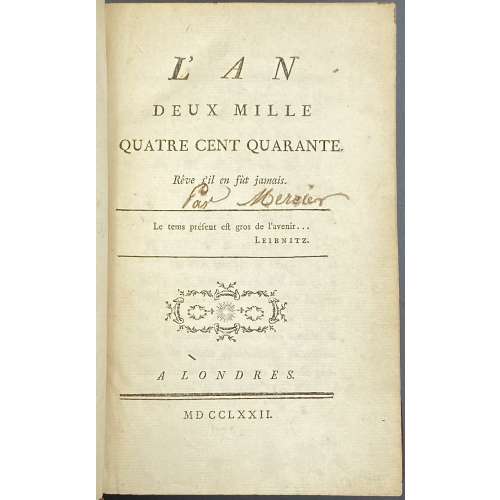 Title page: L'AN DEUX MILLE QUATRE CENT QUARANTE. | Rêve s'il en fût jamais. | Le temps présent est gros de l'avenir... | Leibnitz. | {letterpress device} | A LONDRES. | MD CCLXXII. || Pagination: [i-iv] v-xii, 1-402 [2]; Collation: 8vo; π6 A-Z8 Aa-Bb8 Cc2. Binding: 19 x 12 cm, full mottled calf, rebacked, spine with gilt-lettered red label, compartments ruled gilt, with gilt fleuron ornament, marbled endpapers and all edges; printed on laid paper, with tall “s”. Probably published in Paris, anonymously. Handwritten nut-ink inscription to the title "Par Mercier". See also: LIB-0979.2016
Title page: L'AN DEUX MILLE QUATRE CENT QUARANTE. | Rêve s'il en fût jamais. | Le temps présent est gros de l'avenir... | Leibnitz. | {letterpress device} | A LONDRES. | MD CCLXXII. || Pagination: [i-iv] v-xii, 1-402 [2]; Collation: 8vo; π6 A-Z8 Aa-Bb8 Cc2. Binding: 19 x 12 cm, full mottled calf, rebacked, spine with gilt-lettered red label, compartments ruled gilt, with gilt fleuron ornament, marbled endpapers and all edges; printed on laid paper, with tall “s”. Probably published in Paris, anonymously. Handwritten nut-ink inscription to the title "Par Mercier". See also: LIB-0979.2016 -
![Le Comte de Arthur Grandeffe. Paris sous Napoléon III. Mémoires d'un homme du monde de 1857 à 1870 / Par Le Comte de Arthur Grandeffe. — Paris: Imp. et Lib. Centrales des Chemins de Fer, A. Chaix et Cie., 1870. — pp.: ff [2 ht, blank] [2 title, blank] [i] i-vi, 1-413 [1] bf.](https://varshavskycollection.com/wp-content/uploads/2021/02/LIB-2449.2020-a-1-500x500.jpeg) Front wrapper: PARIS SOUS NAPOLÉON III | Mémoires d'un homme du monde | DE 1857 À 1870 | PAR LE COMTE DE ARTHUR GRANDEFFE | {publisher’s device} | PARIS: IMPRIMERIE ET LIBRAIRIE CENTRALES DES CHEMINS DE FER | A. CHAIX ET Cie | RUE BERGÈRE 20, PRÈS DU BOULEVARD MONTMARTRE | 1879 || Similar lettering to t.p. Softcover 18.5 x 12 cm, publisher’s original blue wrappers, first and last leaves glued to wrappers, unevenly trimmed, some uncut, pagination [4] [i] ii-vi, [1] 2-413 [414], authors advert to back wrapper; mispaginated pp. 136-141; collation: 18mo, π6, 1-2218 236. Sticker with gilt lettering to front wrapper “LIBRAIRIE CENTRALE | BERTRAND & QUEYROT | MENTON”; sticker to spine "577".
Front wrapper: PARIS SOUS NAPOLÉON III | Mémoires d'un homme du monde | DE 1857 À 1870 | PAR LE COMTE DE ARTHUR GRANDEFFE | {publisher’s device} | PARIS: IMPRIMERIE ET LIBRAIRIE CENTRALES DES CHEMINS DE FER | A. CHAIX ET Cie | RUE BERGÈRE 20, PRÈS DU BOULEVARD MONTMARTRE | 1879 || Similar lettering to t.p. Softcover 18.5 x 12 cm, publisher’s original blue wrappers, first and last leaves glued to wrappers, unevenly trimmed, some uncut, pagination [4] [i] ii-vi, [1] 2-413 [414], authors advert to back wrapper; mispaginated pp. 136-141; collation: 18mo, π6, 1-2218 236. Sticker with gilt lettering to front wrapper “LIBRAIRIE CENTRALE | BERTRAND & QUEYROT | MENTON”; sticker to spine "577". -
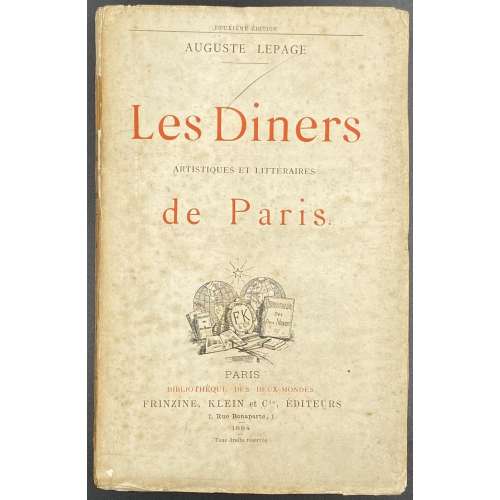 Cover: Publisher's wrappers, to front cover with black and red lettering: DEUXIÈME ÉDITION |—| AUGUSTE LEPAGE | Les Diners | ARTISTIQUES ET LITTÉRAIRES | de Paris | {publisher's device} | PARIS | BIBLIOTHÈQUE DES DEAUX MONDES| FRINZINE, KLEIN et Cie, ÉDIREURS | 1, RUE BONAPARTE, 1 | 1884 | Tous droits réservés || Title page: Similar lettering t.p. in black only, with "DEUXIÈME ÉDITION" below "de Paris". Pagination: front wrapper with a pasted leaf, [iii-vii] viii-xi [xii] [1-3] 4-360, back wrapper with a pasted 3/4 leaf, black lattering to spine. Collation: 18mo; π5, 1-1918-206.
Cover: Publisher's wrappers, to front cover with black and red lettering: DEUXIÈME ÉDITION |—| AUGUSTE LEPAGE | Les Diners | ARTISTIQUES ET LITTÉRAIRES | de Paris | {publisher's device} | PARIS | BIBLIOTHÈQUE DES DEAUX MONDES| FRINZINE, KLEIN et Cie, ÉDIREURS | 1, RUE BONAPARTE, 1 | 1884 | Tous droits réservés || Title page: Similar lettering t.p. in black only, with "DEUXIÈME ÉDITION" below "de Paris". Pagination: front wrapper with a pasted leaf, [iii-vii] viii-xi [xii] [1-3] 4-360, back wrapper with a pasted 3/4 leaf, black lattering to spine. Collation: 18mo; π5, 1-1918-206. -
![Les Bienfaits de L'Empire par Alexandre Bradier. — 8e édition. — Comité politique plébiscitarire. — Paris: Belleville, [1870].](https://varshavskycollection.com/wp-content/uploads/2021/02/LIB-1002.2016-a-500x500.jpeg) Front wrapper: Comité politique plébiscitaire | 17, rue de Surène, PARIS, VIIIe | {Napoleon III portrait} | NAPOLÉON III, EMPEREUR | LES BIENFAITS DE L'EMPIRE || Title page: in a double-fillet frame with years in corners: 1848, 1851, 1852, 1870 || LES | BIENFAITS DE L'EMPIRE | PAR | ALEXANDRE BRADIER | {quotation from Napoléon Ier} | {quotation from Napoléon III} | {quotation from Prince Napoléon} | HUITIÈME EDITION | IMPRIMERIES BELLEVILLE | 29 — Rue du Moulin-Vert — 29 | PARIS (XIVe) | Tous Droits réservés || Pagination: [1-3] 4-62 [2 table] 15.5 x 12 cm brochure in publisher’s original lavender wrappers, front cover discoloured to grey, with publisher’s advert to back wrapper. Printed by Imprimeries Bellville. Published by Comité politique plébiscitaire.
Front wrapper: Comité politique plébiscitaire | 17, rue de Surène, PARIS, VIIIe | {Napoleon III portrait} | NAPOLÉON III, EMPEREUR | LES BIENFAITS DE L'EMPIRE || Title page: in a double-fillet frame with years in corners: 1848, 1851, 1852, 1870 || LES | BIENFAITS DE L'EMPIRE | PAR | ALEXANDRE BRADIER | {quotation from Napoléon Ier} | {quotation from Napoléon III} | {quotation from Prince Napoléon} | HUITIÈME EDITION | IMPRIMERIES BELLEVILLE | 29 — Rue du Moulin-Vert — 29 | PARIS (XIVe) | Tous Droits réservés || Pagination: [1-3] 4-62 [2 table] 15.5 x 12 cm brochure in publisher’s original lavender wrappers, front cover discoloured to grey, with publisher’s advert to back wrapper. Printed by Imprimeries Bellville. Published by Comité politique plébiscitaire. -
![[Charles Octave Moget, Joseph Décembre]. Sempronius. Histoire de la Commune de Paris en 1871. Paris, Décembre-Alonnier, [1871]. – pp: [i, ii - ht, imprim.] iii, iv - t.p., blank] [v - table] vi-viii (viii numbered iii), [1] 2 [3] 4-267 [268 blank] [1] 2-12 advert. [Pseudonym of Charles Octave Moget and Joseph Décembre]. Charles Octave Moget, dit Octave Féré (1815-1875); Joseph Décembre, dit Décembre-Allonier (1836 – 1906).](https://varshavskycollection.com/wp-content/uploads/2021/02/LIB-2445.2020-a-1-500x500.jpeg) Front publisher’s yellow wrapper, in a double frame: SEMPRONIUS | HISTOIRE | DE LA | COMMUNE DE PARIS | EN 1871 | La période impériale. – La Révolution du 4 Septembre. – Le | gouvernement de la Défense nationale. – Le Parti républicain | et le Parti socialiste. – L'Association internationale des | travailleurs. – Menées du parti socialiste. – La Commune en 1793. – Le 31 octobre et le 22 janvier. – La Capitulation de | Paris. – Le 18 mars. – L'Assassinat des généraux Clément | Thomas et Lecomte. – Le Comité central de la Garde nationale. | – La Commune ; – Ses Agissement. – Son Budget. – La | Terreur. – Insolence des Fédérés. – Les journaux. – Les Otages. | – Les Opérations militaires. – Les Fusillades. – Les Vols. – Les | Barricades. – Les Incendies. – Documents officiels de la Commune. | TROISIÈME ÉDITION | PARIS, DECEMBRE - ALONNIER, LIBRAIRE-ÉDITEUR | 20 RUE SEGUR, 20 | PRÉS DE LA PLACE SAINT-ANDR -DES-ARTS || Title page: similar to the cover with no frame. Pagination: front wrapper, [2] – h.t. / imprint., [2] – t.p. / blank, [i] – table de matières, vi (i.e. ii), vii (i.e. iii), iii (i.e. iv), [1] 2-267 [268 blank], [1] 2-12 – publisher's advert., back wrapper. Collation : 18mo ; π4, 1-1518, ß6. Binding: 18.5 x 12 cm; softcover; original yellow wrappers, black lettering to covers and spine; almost disbound. Réferences: Le Quillec (1997): 2324; University of Sussex > Paris Commune Collection. Author of the book: "SEMPRONIUS" was in reality two men: Moget, Charles Octave [Féré, Octave] (French, 1815 – 1875) and Décembre, Joseph [Décembre-Allonier] (French, 1836 – 1906).
Front publisher’s yellow wrapper, in a double frame: SEMPRONIUS | HISTOIRE | DE LA | COMMUNE DE PARIS | EN 1871 | La période impériale. – La Révolution du 4 Septembre. – Le | gouvernement de la Défense nationale. – Le Parti républicain | et le Parti socialiste. – L'Association internationale des | travailleurs. – Menées du parti socialiste. – La Commune en 1793. – Le 31 octobre et le 22 janvier. – La Capitulation de | Paris. – Le 18 mars. – L'Assassinat des généraux Clément | Thomas et Lecomte. – Le Comité central de la Garde nationale. | – La Commune ; – Ses Agissement. – Son Budget. – La | Terreur. – Insolence des Fédérés. – Les journaux. – Les Otages. | – Les Opérations militaires. – Les Fusillades. – Les Vols. – Les | Barricades. – Les Incendies. – Documents officiels de la Commune. | TROISIÈME ÉDITION | PARIS, DECEMBRE - ALONNIER, LIBRAIRE-ÉDITEUR | 20 RUE SEGUR, 20 | PRÉS DE LA PLACE SAINT-ANDR -DES-ARTS || Title page: similar to the cover with no frame. Pagination: front wrapper, [2] – h.t. / imprint., [2] – t.p. / blank, [i] – table de matières, vi (i.e. ii), vii (i.e. iii), iii (i.e. iv), [1] 2-267 [268 blank], [1] 2-12 – publisher's advert., back wrapper. Collation : 18mo ; π4, 1-1518, ß6. Binding: 18.5 x 12 cm; softcover; original yellow wrappers, black lettering to covers and spine; almost disbound. Réferences: Le Quillec (1997): 2324; University of Sussex > Paris Commune Collection. Author of the book: "SEMPRONIUS" was in reality two men: Moget, Charles Octave [Féré, Octave] (French, 1815 – 1875) and Décembre, Joseph [Décembre-Allonier] (French, 1836 – 1906). -
![Charles Virmaître. Paris-Canard. – Paris: Albert Savine, 1888. – pp.: ffl [2 blanks] [2 orig. yellow cover, verso blank] [2 - ht, advert.] [2 - t.p., blank] 1-319 [320 blank] [2 back orig. cover, recto blank]. [Autograph].](https://varshavskycollection.com/wp-content/uploads/2021/02/LIB-2535.2020-c-500x500.jpeg) Cover: (original wrapper) PARIS-CANARD| PAR | CH. VIRMAITRE | A. SAVINE, Édeiteur, rue Drouot, 18, PARIS || Wood engraving to cover signed LeNatur — Michelet, sc. Title page: CHARLES VIRMAITRE | PARIS–CANARD | {publisher’s device} | PARIS | NOUVELLE LIBRAIRIE PARISIENNE | ALBERT SAVINE, ÉDITEUR | 18, RUE DROUOT, 18 | 1888 | Tous droits réservés. || Pagination: 2 blank leaves, original pictorial wrapper, [4], [1] 2-319 [320 blank], original back wrapper with publisher’s advertisement, 2 blank leaves. Collation: 12mo; π2, 1-1712 184. Binding: 18 x 12 cm, hardcover; quarter blue percaline, marbled boards, red title label ruled gilt with gilt lettering, gilt double tail ruler, fleuron to spine; original paper wrappers preserved. Bookplate to front pastedown: "EX LIBRIS EUGENE SELIGMANN" written on a ribbon; ink inscription to half-title in french: "To my good friends Paul Vogler and Maurice Radiguet, former – for a new acquaintance, latter – to become great." Signed: Ch. Virmaitre. Paul Vogler (French, 1853 – 1904) – painter in the Impressionist style. Jules Maurice Radiguet (French, 1866 – 1941) – illustrator , caricaturist and cartoonist. Father of Raymond Radiguet (French, 1903 – 1923).
Cover: (original wrapper) PARIS-CANARD| PAR | CH. VIRMAITRE | A. SAVINE, Édeiteur, rue Drouot, 18, PARIS || Wood engraving to cover signed LeNatur — Michelet, sc. Title page: CHARLES VIRMAITRE | PARIS–CANARD | {publisher’s device} | PARIS | NOUVELLE LIBRAIRIE PARISIENNE | ALBERT SAVINE, ÉDITEUR | 18, RUE DROUOT, 18 | 1888 | Tous droits réservés. || Pagination: 2 blank leaves, original pictorial wrapper, [4], [1] 2-319 [320 blank], original back wrapper with publisher’s advertisement, 2 blank leaves. Collation: 12mo; π2, 1-1712 184. Binding: 18 x 12 cm, hardcover; quarter blue percaline, marbled boards, red title label ruled gilt with gilt lettering, gilt double tail ruler, fleuron to spine; original paper wrappers preserved. Bookplate to front pastedown: "EX LIBRIS EUGENE SELIGMANN" written on a ribbon; ink inscription to half-title in french: "To my good friends Paul Vogler and Maurice Radiguet, former – for a new acquaintance, latter – to become great." Signed: Ch. Virmaitre. Paul Vogler (French, 1853 – 1904) – painter in the Impressionist style. Jules Maurice Radiguet (French, 1866 – 1941) – illustrator , caricaturist and cartoonist. Father of Raymond Radiguet (French, 1903 – 1923). -
![Charles Virmaitre. Paris-police. — Paris: E. Dentu, 1886. — pp.: [2 wrapper], [2 half-title], 2 title] 1-359 [1 blank], back wrapper.](https://varshavskycollection.com/wp-content/uploads/2021/02/LIB-1130.2016-d-scaled-500x500.jpeg) Cover: (black and red in red frame) PARIS POLICE | par | Ch. Virmaitre | PARIS | E. DENTU, ÉDITEUR | LIBRAIRE DE LA SOCIÉTÉ DES GENTES DE LETTRES | Palais-Royal, 15-17-19, Galerie d’Orléans | 1886 || Title page: CH. VIRMAITRE | PARIS–POLICE | {publisher’s device} | PARIS | E. DENTU, ÉDITEUR | LIBRAIRE DE LA SOCIÉTÉ DES GENTES DE LETTRES | PALAIS-ROYAL, 15-17-19, GALERIE D’ORLEANS | 1886 | Tous droits réservés. || Pagination : 3 blank leaves, original pictorial wrapper, [4], [1] 2-359 [360 blank], original back wrapper with publisher's advertisement, 3 blank leaves. Collation: 12mo; π2, 1-1912 206. Binding: owner's hardcover, quarter burgundy percaline, marbled boards, brown title label with gilt lettering, gilt double tail ruler, year, and fleuron to spine; original paper wrappers preserved.
Cover: (black and red in red frame) PARIS POLICE | par | Ch. Virmaitre | PARIS | E. DENTU, ÉDITEUR | LIBRAIRE DE LA SOCIÉTÉ DES GENTES DE LETTRES | Palais-Royal, 15-17-19, Galerie d’Orléans | 1886 || Title page: CH. VIRMAITRE | PARIS–POLICE | {publisher’s device} | PARIS | E. DENTU, ÉDITEUR | LIBRAIRE DE LA SOCIÉTÉ DES GENTES DE LETTRES | PALAIS-ROYAL, 15-17-19, GALERIE D’ORLEANS | 1886 | Tous droits réservés. || Pagination : 3 blank leaves, original pictorial wrapper, [4], [1] 2-359 [360 blank], original back wrapper with publisher's advertisement, 3 blank leaves. Collation: 12mo; π2, 1-1912 206. Binding: owner's hardcover, quarter burgundy percaline, marbled boards, brown title label with gilt lettering, gilt double tail ruler, year, and fleuron to spine; original paper wrappers preserved. -
![Charles Virmaitre. Paris qui s'efface. — Paris: Albert Savine, 1887. — 2me édition. — pp.: [2 blanks] [2 hf-t, advert.] [t.p., blank] [2 dedicat., blank] [1, 2 - chap.1 cont., blank] [2-3] 4-314 [2 blanks].](https://varshavskycollection.com/wp-content/uploads/2021/02/LIB-2453.2020-a-1-scaled-500x500.jpeg) Title page: CHARLES VIRMAITRE | PARIS | qui s'efface | {publisher’s device} | PARIS | NOUVELLE LIBRAIRIE PARISIENNE | ALBERT SAVINE, ÉDITEUR | 18, RUE DROUOT, 18 | 1887 | Tous droits réservés. || Collation: Front pictorial wrapper, ffl, π3 1-1712 181, bfl, back wrapper w/publ. advert. Pagination: [6] [1-3] 4-314.
Title page: CHARLES VIRMAITRE | PARIS | qui s'efface | {publisher’s device} | PARIS | NOUVELLE LIBRAIRIE PARISIENNE | ALBERT SAVINE, ÉDITEUR | 18, RUE DROUOT, 18 | 1887 | Tous droits réservés. || Collation: Front pictorial wrapper, ffl, π3 1-1712 181, bfl, back wrapper w/publ. advert. Pagination: [6] [1-3] 4-314. -
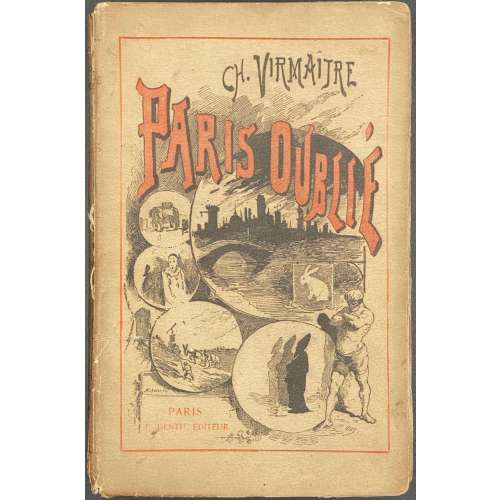 Cover: CH. VIRMAÎTRE | PARIS OUBLIÉ — PARIS | E. DENTU, ÉDITEUR || Title page: CHARLES VIRMAÎTRE | PARIS OUBLIÉ | {publisher’s device} | PARIS | E. DENTU, ÉDITEUR | LIBRAIRE DE LA SOCIÉTÉ DES GENTES DE LETTRES | PALAIS-ROYAL, 15-17-19, GALERIE D’ORLÉANS | 1886 | Tous droits réservés. || Pagination: publisher’s pictorial wrapper, ffl, [2] – t.p. / blank, 1-327 [328 blank], bfl, publisher’s advert. to back wrapper.
Cover: CH. VIRMAÎTRE | PARIS OUBLIÉ — PARIS | E. DENTU, ÉDITEUR || Title page: CHARLES VIRMAÎTRE | PARIS OUBLIÉ | {publisher’s device} | PARIS | E. DENTU, ÉDITEUR | LIBRAIRE DE LA SOCIÉTÉ DES GENTES DE LETTRES | PALAIS-ROYAL, 15-17-19, GALERIE D’ORLÉANS | 1886 | Tous droits réservés. || Pagination: publisher’s pictorial wrapper, ffl, [2] – t.p. / blank, 1-327 [328 blank], bfl, publisher’s advert. to back wrapper. -
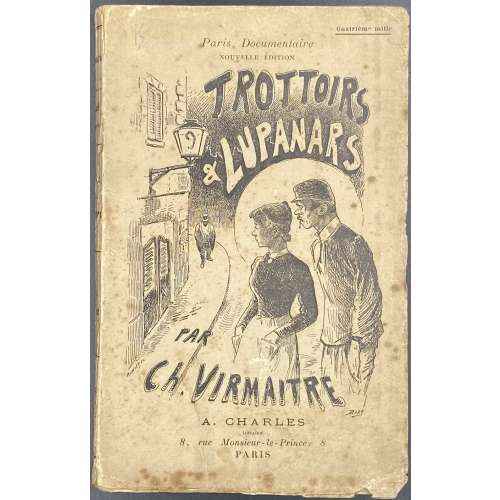 Front wrapper: Quatrième mille | Paris Documentaire | NOUVELLE ÉDITION | TROTTOIRS | ET | LUPANARS | PAR | Ch. VIRMAITRE | A. CHARLES | LIBRAIRE | 8, Rue Monsieur-le-Prince, 8 | PARIS || Title page: Ch. VIRMAITRE | PARIS DOCUMENTAIRE | (Mœurs) | TROTTOIRS | ET | LUPANARS | {fleuron} | A. CHARLES | LIBRAIRE | 8, Rue Monsieur-le-Prince, 8 | PARIS | 1897 || Collation: 18mo; Front pictorial wrapper, 2 ffls, π4, 118, 318, 518, 718, 918, 1118, 1318, 1514, back pictorial wrapper (portrait) Pagination: [1-7] 8-282 [6]. Binding: Publisher’s pictorial wrappers, lettering to spine. Charles Virmaître (French, 1835 – 1903).
Front wrapper: Quatrième mille | Paris Documentaire | NOUVELLE ÉDITION | TROTTOIRS | ET | LUPANARS | PAR | Ch. VIRMAITRE | A. CHARLES | LIBRAIRE | 8, Rue Monsieur-le-Prince, 8 | PARIS || Title page: Ch. VIRMAITRE | PARIS DOCUMENTAIRE | (Mœurs) | TROTTOIRS | ET | LUPANARS | {fleuron} | A. CHARLES | LIBRAIRE | 8, Rue Monsieur-le-Prince, 8 | PARIS | 1897 || Collation: 18mo; Front pictorial wrapper, 2 ffls, π4, 118, 318, 518, 718, 918, 1118, 1318, 1514, back pictorial wrapper (portrait) Pagination: [1-7] 8-282 [6]. Binding: Publisher’s pictorial wrappers, lettering to spine. Charles Virmaître (French, 1835 – 1903). -
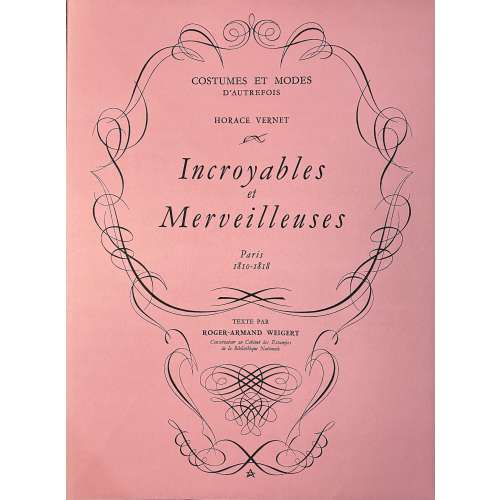 Title: COSTUMES ET MODES | D’AUTREFOIS | HORACE VERNET | Incroyables | et | Merveilleuses | Paris | 1810–1818 | TEXTE PAR | ROGER–ARMAND WEIGERT | Conservateur au Cabinet des Estampes | de la Bibliothèque Nationale | ÉDITIONS ROMBALDI | PARIS || Content: 24 photomechanical reproductions of the images from Bibliothèque nationale de France, printed on vélin paper from Papeteries Aussedat by Papeteries de la Moselle printing presses and stencil-coloured by Edmond Vairel. Text printed by Imprimerie Kapp on October 20, 1955. A print run of 4,000 copies, of which this is №122. Exterior: Pink lettered dust jacket over wrappers. Pagination: loose double leaves, [4 blanks] [4 h.t. and t.p.], i-xi [xii], 24 unnumbered plates, [4 blanks].
Title: COSTUMES ET MODES | D’AUTREFOIS | HORACE VERNET | Incroyables | et | Merveilleuses | Paris | 1810–1818 | TEXTE PAR | ROGER–ARMAND WEIGERT | Conservateur au Cabinet des Estampes | de la Bibliothèque Nationale | ÉDITIONS ROMBALDI | PARIS || Content: 24 photomechanical reproductions of the images from Bibliothèque nationale de France, printed on vélin paper from Papeteries Aussedat by Papeteries de la Moselle printing presses and stencil-coloured by Edmond Vairel. Text printed by Imprimerie Kapp on October 20, 1955. A print run of 4,000 copies, of which this is №122. Exterior: Pink lettered dust jacket over wrappers. Pagination: loose double leaves, [4 blanks] [4 h.t. and t.p.], i-xi [xii], 24 unnumbered plates, [4 blanks].Weigert, Roger-Armand (French, 1907-1986).
Émile Jean-Horace Vernet [Horace Vernet] (French, 1789 – 1863). Gatine, Georges Jacques (French, 1773 – after 1841). -
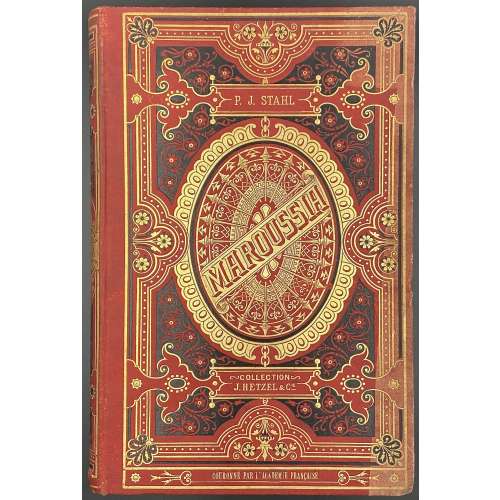 Title: MAROUSSIA | PAR | P.-J. STAHL | D'APRÈS UNE LÉGENDE DE MARKOWOVZOK | DESSINS PAR TH. SCHULER | GRAVURES PAR PANNEMAKER | {vignette} | BIBLIOTHÈQUE | D'ÉDUCATION ET DE RÉCRÉATION | J. HETZEL ET Cie, 18, RUE JACOB | PARIS | Tous droits de reproduction et de traduction réservés || Pagination: [2] – t.p. / blank, [1, 2] – dedication / blank, [3] 4-272, [1] 2-11 [12] – publisher’s advert.; Frontispiece and 22 leaves of wood-engraved plates by F. Pannemaker after Th. Schuler, extraneous to collation, woodcut head- and tailpieces, vignettes in the text by Charles Baude. Collation: 4to; 1-344, + 6 leaves of publisher's advertisement. Binding: “Cartonnage Hetzel” – red cloth stamped in gilt and black with the elements of design to spine, front and back, publisher's device to back, AEG. Author and publisher: Pierre-Jules Hetzel [P.-J. Stahl] (French, 1814 – 1886). Artist: Jules Théophile Schuler (French, 1821 – 1878). Engravers: Adolphe François Pannemaker (Belgian-French, 1822 – 1900) and Charles Baude (French, 1853 – 1935). Author of the legend: Markowovzok [Marko Vovchok; Марко́ Вовчо́к, real name Mariya Vilinskаya; Мария Александровна Вилинская] (Ukrainian, 1833 – 1907). Series: Collection Hetzel (stamped on the front board). Typographie A. Lahure (Paris), Alexis Lahure (French, 1849 – 1929). MAROUSSIA – The French version of the Ukrainian name Маруся.
Title: MAROUSSIA | PAR | P.-J. STAHL | D'APRÈS UNE LÉGENDE DE MARKOWOVZOK | DESSINS PAR TH. SCHULER | GRAVURES PAR PANNEMAKER | {vignette} | BIBLIOTHÈQUE | D'ÉDUCATION ET DE RÉCRÉATION | J. HETZEL ET Cie, 18, RUE JACOB | PARIS | Tous droits de reproduction et de traduction réservés || Pagination: [2] – t.p. / blank, [1, 2] – dedication / blank, [3] 4-272, [1] 2-11 [12] – publisher’s advert.; Frontispiece and 22 leaves of wood-engraved plates by F. Pannemaker after Th. Schuler, extraneous to collation, woodcut head- and tailpieces, vignettes in the text by Charles Baude. Collation: 4to; 1-344, + 6 leaves of publisher's advertisement. Binding: “Cartonnage Hetzel” – red cloth stamped in gilt and black with the elements of design to spine, front and back, publisher's device to back, AEG. Author and publisher: Pierre-Jules Hetzel [P.-J. Stahl] (French, 1814 – 1886). Artist: Jules Théophile Schuler (French, 1821 – 1878). Engravers: Adolphe François Pannemaker (Belgian-French, 1822 – 1900) and Charles Baude (French, 1853 – 1935). Author of the legend: Markowovzok [Marko Vovchok; Марко́ Вовчо́к, real name Mariya Vilinskаya; Мария Александровна Вилинская] (Ukrainian, 1833 – 1907). Series: Collection Hetzel (stamped on the front board). Typographie A. Lahure (Paris), Alexis Lahure (French, 1849 – 1929). MAROUSSIA – The French version of the Ukrainian name Маруся. -
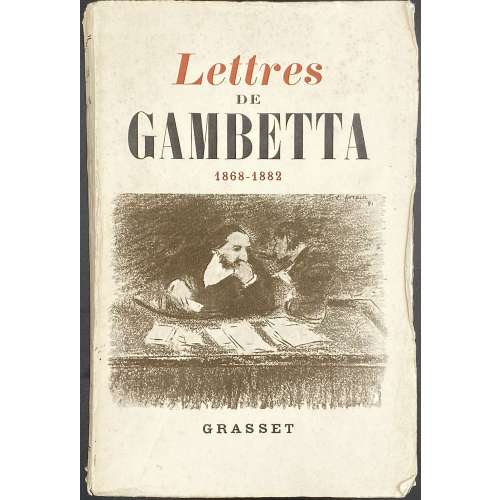 Title: LETTRES DE GAMBETTA | 1868 – 1882 | recueillies et annotées par | DANIEL HALÉVY ET ÉMILE PILLIAS | ÉDITIONS BERNARD GRASSET | 61, RUE DES SAINTS-PÈRES, VIe | PARIS || Collation: 8vo; [1]8 2-428, unpaginated, (336 leaves) + 4 leaves of plates extraneous to collation, untrimmed wove paper, 587 letters, printed on the 25th of March 1938 by Floch (Mayenne); limited edition, unnumbered copy. Binding: original publisher’s pictorial wrappers, lettering to spine. Series: "Documents", pub. sous la direction de la Société d'histoire de la troisième république. Insert: Lettre Autographe Signée (LAS): Ludovic Halévy (French, 1834 – 1908). Transcript:
Title: LETTRES DE GAMBETTA | 1868 – 1882 | recueillies et annotées par | DANIEL HALÉVY ET ÉMILE PILLIAS | ÉDITIONS BERNARD GRASSET | 61, RUE DES SAINTS-PÈRES, VIe | PARIS || Collation: 8vo; [1]8 2-428, unpaginated, (336 leaves) + 4 leaves of plates extraneous to collation, untrimmed wove paper, 587 letters, printed on the 25th of March 1938 by Floch (Mayenne); limited edition, unnumbered copy. Binding: original publisher’s pictorial wrappers, lettering to spine. Series: "Documents", pub. sous la direction de la Société d'histoire de la troisième république. Insert: Lettre Autographe Signée (LAS): Ludovic Halévy (French, 1834 – 1908). Transcript:Mercredi, Mon cher ami, Reçois mes bien sincères et bien affectueuses félicitations. Si tu continues à marcher de ce pas tu en seras bientôt en grande situation et ce sera justice, et j’en serais bien heureux n’en doute pas. Tout à toi Ludovic Halévy
Gambetta, Léon (French, 1838 – 1882). Halévy, Daniel (French, 1872 – 1962). Pillias, Émile (French, 1905 – 1940). -
![Henri Rollin. L'apocalypse de notre temps / Les dessous de la propagande allemande d'après des documents inédits. — NRF [Nouvelle Revue Française], — Paris: Gallimard, 1939. — Series: Problémes et documents. pp.: [1-9] 10-567 [9].](https://varshavskycollection.com/wp-content/uploads/2021/02/LIB-0371.2015-a-500x500.jpeg) Title: PROBLÈMES ET DOCUMENTS | HENRI ROLLIN | L'APOCALYPSE | DE | NOTRE TEMPS | Les dessous de la propagande allemande | d'après des documents inédits | nrf | S. P. | GALLIMARD | Paris — 43, rue de Beaune Pagination: [1-9] 10-567 [9]. Size: 22.6 x 14.2 cm Binding: original publisher's wrappers. Ex libris Lorenzo Grazzini of Librairie Scritti (book store in Paris). Publishing Year: 1939; Publisher: Gallimard; Acheve d'impremier - Le 23 Septembre 1939 par l'Impremierie Orleanaise 68, rue Royale, Orleans.
Title: PROBLÈMES ET DOCUMENTS | HENRI ROLLIN | L'APOCALYPSE | DE | NOTRE TEMPS | Les dessous de la propagande allemande | d'après des documents inédits | nrf | S. P. | GALLIMARD | Paris — 43, rue de Beaune Pagination: [1-9] 10-567 [9]. Size: 22.6 x 14.2 cm Binding: original publisher's wrappers. Ex libris Lorenzo Grazzini of Librairie Scritti (book store in Paris). Publishing Year: 1939; Publisher: Gallimard; Acheve d'impremier - Le 23 Septembre 1939 par l'Impremierie Orleanaise 68, rue Royale, Orleans.


